Basic information about the 1-1-3 zone defense in basketball
General definition of 1-1-3 zone defense
The 1-1-3 zone defense is a basketball strategy that seeks to prevent high quality scoring opportunities of the offensive team, especially near the basket, primarily by using certain on-ball or off-ball defensive actions.
General meaning behind the 1-1-3 numbering style
Essentially, it is called 1-1-3 because each digit represents the general alignment for the defensive players on the court.
To give more clarity of this concept, the digits between dashes represent the number of defensive players that will be located in a certain region of the court, typically based on the front, the middle, or the back.
Also, more dashes in a numbering format generally means more regions for the players to occupy on the court.
Basically, one dash would generally represent two regions of the court that players would fill.
An example of that would be the 2-3 zone defense, which contains two players in the front region and three players in the back region.
Furthermore, two dashes would typically denote three regions for players to occupy on the court.
An example of that would be this particular zone defense, which contains one player in the front region, one player in the middle region, and three additional players in the back region.
In a similar fashion, three dashes would usually be indicative of four regions that players would fill on the court.
An example of that would be the 1-1-2-1 press defense in which the players will align in four regions on the court from the front to the back.
Initial formation for 1-1-3 zone defense
This section contains a diagram example of the initial formation or basic setup for the 1-1-3 zone defense.
Also, in regards to the diagram image below as well as additional diagrams in later sections, each defensive player is indicated by the letter X shown alongside a subscript number.
For the purposes of this web page, this letter X and the adjacent subscript number symbolizes one of the standard basketball positions.
This general rule also applies to offensive players showcased in later sections as well.
However, for those instances, the letter X is not utilized. Instead, offensive players will simply be referred to by their respective number such as 1, 2, or 3.
Essentially, the defensive and offensive point guards are denoted as X1 and 1, respectively.
The defensive and offensive shooting guards are indicated as X2 and 2, respectively.
The defensive and offensive small forwards are represented as X3 and 3, respectively.
The defensive and offensive power forwards are signified as X4 and 4, respectively.
Finally, the defensive and offensive centers are denoted as X5 and 5, respectively.
1-1-3 zone defense basic setup
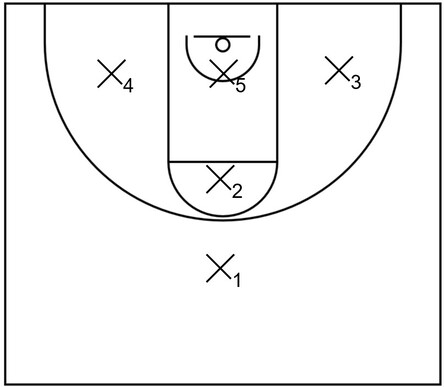
In terms of the basic setup: X1 is at the top or front region of the zone; X2 is in the middle region near the high post, also known as the nail area; X3, X4, and X5 are located at the bottom or back region of the zone.
More specifically for the defenders in the back region; X3 hovers around the space between the right side low post area and right side corner; X4 covers the general area between the left side corner and left side low post area; X5 stands in front of the basket within the lane, which is also just above the restricted area, if applicable.
Affiliate Disclosure: I may earn a commission on qualifying purchases made through the links below.
Examples of 1-1-3 zone defensive rotations
This section contains examples of various areas of the court that defenders could rotate towards while implementing the 1-1-3 zone defense, primarily depending on the location of the ball and/or the offensive team’s general actions.
1-1-3 zone defense with pressure and match-up principles
The following diagrams within this section demonstrate an example of a 1-1-3 zone defense that emphasizes match-up principles in relation to on-ball pressure, influencing the ball towards one side of the floor and keeping it on that same side as much as possible, and hindering direct drives or passes within a straight line towards the basket.
It is based on insights from The Pressure 1-1-3 Zone Defense by Bob Huggins.
Furthermore, it is important to note that in general, when moving from one location within the zone to another area, defenders will typically have to sprint, as opposed to casually sliding.
This is because defenders will usually have to cover quite a bit of ground while guarding different areas within the zone, especially off the ball.
However, if those defenders simply slide casually, especially as off-ball defenders, the offense may be able to take advantage of possible gaps within the zone.
In other words, depending on where the ball is located, if defenders are not in correct spots, then the offensive players might be able to dribble, pass, or potentially cut into open spaces, which could lead to a breakdown of the zone.
It should be noted that each of the defenders, especially on-ball defenders, should execute the proper defensive stance. That is feet slightly wider than shoulder width apart, knees slightly bent, back straightened as much as possible, and eyes up and forward watching the ball and the offensive players.
What’s more, each defender should try to stay on the ball of their feet as much as possible and have their hands up with their arms extended away from the sides of their body.
By doing that, defenders will usually be able to react more quickly and efficiently to actions of one or more offensive players.
Also, when defenders’ hands are up and active, it is typically more difficult for offensive players with or without possession of the basketball to move around that defender or even hinder that defender’s movement such as with a screen.
Moreover, especially in reference to this particular example of the 1-1-3 zone, when defenders’ hands are high, it is more challenging for offensive players to take uncontested jump shots or execute straight line passes towards the basket.
Example 1: Initial on-ball pressure when the ball is near the top
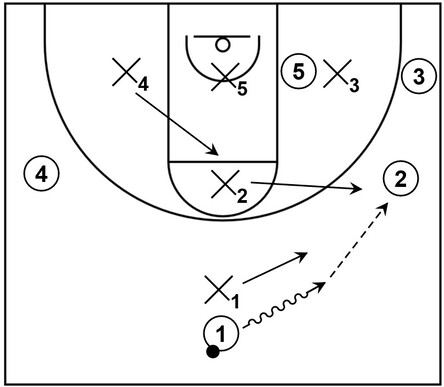
At the beginning of the defensive sequence, X1 puts immediate pressure on the player in current possession of the basketball (in this case, that being 1), and influences that player towards one side of the floor.
In this instance, 1 dribbles towards the right side of the floor due to the pressure of X1.
When that occurs, X2 sprints over from the middle region or nail area towards the right side wing while X4 sprints up into the lane just below the free throw line.
In addition, for the time being, X2 shouldn’t deny the wing pass towards 2. As mentioned earlier, the general objective is to influence the ball towards one side of the court and keep it there as much as possible.
Assuming 2 receives the ball from 1 as shown on the diagram, X2 is now ready to defend with adequate pressure.
Moreover, it should be noted that X4 can also guard against any passes toward the high post after sprinting towards that general area.
Example 2: General defensive actions when the ball is on the wing
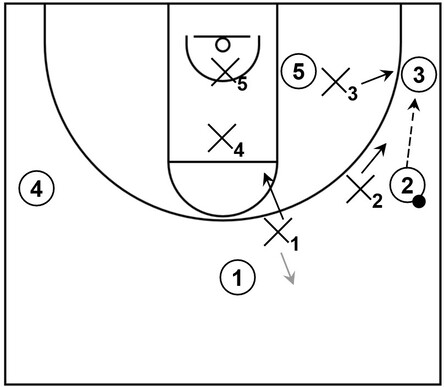
For this diagram, 2 has possession of the ball on the right side wing.
When that happens, X2 immediately puts pressure on the ball while X1 initially denies the ball reversal towards the top with a hand in the passing lane, represented by the gray arrow.
Also, note that while 2 is in possession of the ball, X2 is slightly below, influencing the offensive player towards the baseline or away from the middle.
Again, this is another way to keep the ball on one side of the floor in the event that 2 decides to dribble it.
However, it is also important to mention that X2 should not give up a straight line pathway to the basket, in which 2 is able to dribble into the gap that would be between X2 and X3.
What’s more, notice that X3 has moved slightly up towards the ball near the imaginary line between 2 and 5 (side note: in the triangle offense, this is known as the line of deployment) and away from the offensive player in the corner.
This is useful defensively for at least a couple of reasons. First, if 2 dribbles toward the baseline, then it would be difficult to do anything beneficially with the basketball, particularly in terms of taking an uncontested shot or passing to a teammate on that same side, one who would most likely not be wide open for a field goal attempt.
Second, since X3 is very close to the strong side low post area, it could be somewhat of a challenge to easily execute an entry pass into 5 at the low post, especially if X2 has high and active hands.
Basically, if 2 were to pass the ball inside to 5 and assuming X2 does not deflect or intercept that pass, X3 could possibly deflect or intercept it as well.
Or on the other hand, if 5 is able to gain possession of the ball, then X3 is nearby to dig in for a steal or possibly perform a double team with X5, mainly to encourage 5 to throw the ball back towards the perimeter and away from the basket.
Also, even if 3 receives the ball from 2, as shown on the diagram, X3 can quickly sprint to closeout and put pressure on the ball.
Additionally, if 3 receives the ball, X1 should sprint back down towards the right side high post area while X2 initially sprints toward the open space between 2 and 3.
Lastly, note that when 3 gains possession of the ball, immediate dribble penetration towards the middle would not be generally feasible because X3 and X2 are near that area, even as X3 recovers to implement on-ball pressure defense.
Example 3: General defensive actions when the ball is in the corner
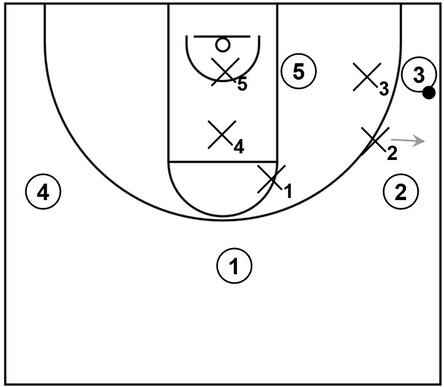
On this diagram, 3 has possession of the ball in the right corner. When that occurs, X3 should sprint to closeout and put pressure on the ball with active hands.
From there, X3 should influence 3 towards the baseline and at the same time, X2 should deny the pass towards 2 by placing a hand in the passing lane, represented by the gray arrow.
It should be noted though in the event that 3 does desire to throw the ball towards 2, the best scenario would be 3 throwing it over the hand of X2.
This is a viable action because that type of throw is not a straight line pass in which 2 could easily catch the ball in triple threat, ready to shoot, dribble, or pass to another teammate.
Putting it another way, if 3 throws the ball over the hand of X2, then it is very likely that 2 will not be able to catch and immediately shoot, dribble, or pass it somewhere else.
Furthermore, there is probably at least a moderate chance that 2 would catch the high arching air pass that is thrown over X2 further away from the basket, which is a boon for the defense.
In addition to that, notice that X1 is near the imaginary line between 1 and 3. This also applies for X4 as well; that is, X4 is near the imaginary line between 3 and 4.
X5 can stay at home and continue to protect the basket, especially against a weak side cut from 4.
What’s more, if 3 decides to drive baseline, X3 should stay in front and eventually try to place a foot on the baseline, which takes away that dribbling path.
In any case, with or without the baseline drive, 3 cannot easily throw straight line passes to any of the other offensive teammates due to the overall positioning of the defenders.
Example 4: Ball gets skipped from right corner to left side wing – Variation A
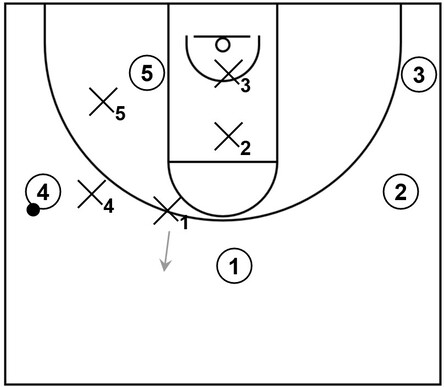
Here is an example of what could possibly happen after the previous diagram if 3 throws a skip pass towards 4.
Additionally, for this case, 5 decided to sprint across the lane to the left side low post area.
As stated earlier, this skip pass may be feasible as long as it is a high arching air pass over the defense, which is commonly slower than a straight line pass.
This gives a defender an opportunity to deflect or intercept the pass, or at the very least, sprint to closeout and put pressure on the ball.
Ideally though, the overall goal is to keep the ball on one side of the floor as long as possible but in certain instances, the offensive team will be able to move it to the other side. Again, if that happens, then it is very preferable that the ball movement is by way of a slow, high arching pass.
In any event, when 4 gains possession of the ball, all of the defenders need to sprint to new areas immediately.
X4 should sprint to closeout on the ball and influence 4 towards the baseline.
For this scenario, X5 can stand in the gap between 4 and 5 in an attempt to hinder or completely discourage the post entry pass.
X3, who was previously guarding near the right side corner, sprints to protect the basket, hindering potential weak side cuts from 2 or 3.
X2, who was previously guarding near the right side wing, sprints toward the lane, just below the high post area.
This also gives X2 an opportunity to deny nay passes toward the high post if an offensive player were to move into that open space.
X1, who is currently one pass away from the ball, denies it towards 1 with a hand in the passing lane, represented by the gray arrow.
Example 5: Ball gets skipped from right corner to left side wing – Variation B
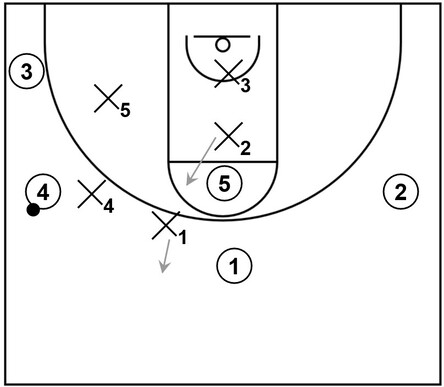
Here is another example of general defensive actions when the ball gets skipped from the right corner to the left side wing. However, this time, 3 ran the baseline to fill the left side corner and 5 flashed up to occupy the high post area.
When that occurs, X4 sprints to closeout and influence 4 towards the baseline, similar to the previous diagram.
X5 stands in the open space between 3 and 4, mainly helping to prevent a straight line drive to the basket by 4.
Also, if X5 has slower footspeed, then it is possible for X5 to take a step back away from the ball and get somewhat closer to the lane line.
That shouldn’t be a big issue as long as X5 remains near the open space between 3 and 4 and is ready to closeout if 3 receives the ball.
X1 denies the pass towards the top, similar to the diagram before while X2 denies the pass into the high post, both instances represented by gray arrows.
Example 6: Ball is in corner followed by defender beaten by baseline drive
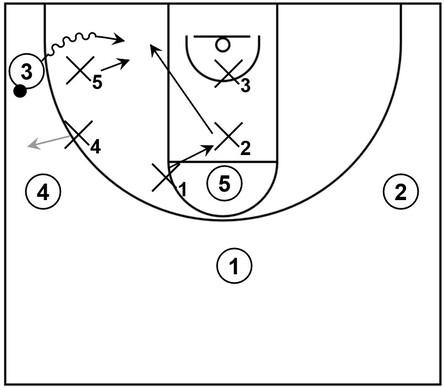
This is an example of defensive actions that could happen if 3 were to receive the ball but X5 was not able to sprint to closeout quickly enough or 3 simply has a speed advantage over X5.
In the event that X5 gets beat, X2 should sprint down to help outside the box near the exterior of the left side lane line.
X1 should drop back to fill and replace within the lane area just below the high post while also denying a pass into that area if necessary.
X4 denies against 4 with a hand in the passing lane, represented by the gray arrow while X3 continues to protect the basket.
Once again, if defenders are in proper positions, it would be generally difficult for 3 to take an uncontested jump shot or execute a straight line pass, specifically towards the basket, especially from their current location.